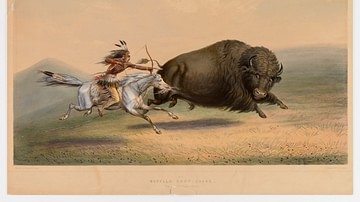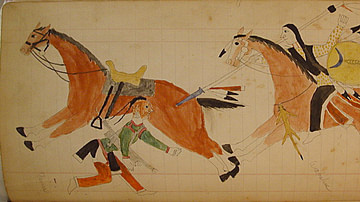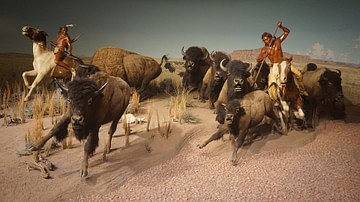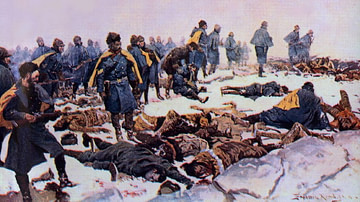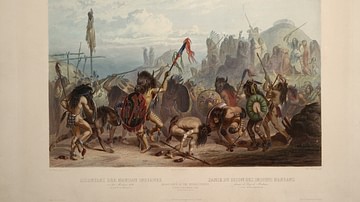Old Woman's Water and the Buffalo Cap is a Cheyenne tale of the two great culture heroes Standing-on-the-Ground and Sweet Medicine and how they brought back the buffalo to the people and established the tradition of the sacred buffalo hat. The story may be read as Part II of the Ehyophsta Legend.
In Ehyophsta, the young woman who has brought the buffalo and other game to the Cheyenne accidentally breaks the taboo set down by her father of never expressing pity for any suffering creature. There are various interpretations of this line but, most likely, the taboo was established by the father figure, Coyote Man, to prevent people from questioning the nature of existence, which was understood as all good as it had been created by Maheo (Wise One Above). In showing pity for a suffering animal, one was claiming to know better than the Creator God how life "should" be.
Once the taboo was broken, the buffalo and other game vanished. They only reappear once Standing-on-the-Ground and Sweet Medicine arrive, consult with the Old Woman of the Spring, and announce the good fortune to the people. Standing-on-the-Ground, in this version of the story, is the Sutai Cheyenne hero who establishes the sacred buffalo hat while, in other – and more popular – versions of the tale it is Erect Horns who gives the hat to the people. Sweet Medicine is responsible in all the stories for giving the people the Four Sacred Arrows, but that tale is not addressed in the following narrative. The Four Arrows and the Buffalo Hat (or Buffalo Cap) are the two most sacred objects to the Cheyenne, both in the past and the present day.
Text
This text is taken from By Cheyenne Campfires (1926) by George Bird Grinnell. According to the author, this version of the story of the return of the buffalo and the gift of the buffalo cap is the oldest on that topic among the Cheyenne.
The people were having a "medicine" hunt; they knew nothing then about the buffalo. Before making a "medicine" hunt, the medicine men all came together and pledged themselves to make a hunt; they appointed a man to be leader and also his wife, so that, when they caught animals, they would get the females as well as the males. After these had pledged themselves, they sent out runners to see what they could find. This was when the Cheyenne were far on the other side of the Missouri River where there are many lakes.
This time, they chose two men to go out to look for ducks, geese, and other birds. The men came back and reported that a certain lake was covered with waterfowl of all kinds; so the whole camp moved over to it, the dogs hauling the travois. The lake was not large, and the men, women, and children, and dogs surrounded it and made a great slaughter of birds, for they had called on the spiritual powers to aid them so that the birds should not fly away.
When they moved again, they sent two more runners ahead to see what they could find. These two went toward a high grassy tableland and climbed up on it. They reached it toward sunset and, as they stood there, they saw the grass moving and found quantities of skunks all around, so they went back to the camp and told what they had seen. Next morning, everybody started for the tableland. They all got around it early in the morning and killed great numbers of skunks; everybody was loaded down with them. The next day, they again sent two men to the same place and many more skunks were seen so that, on this day, more were killed than the day before. They sent them again the next day and, when they had finished killing, they could hardly carry away the meat. Again, a fourth time the two men reported skunks there and many more were caught and killed.
The next day, they camped near a little knoll, where a spring came out of the rock. This spring is called "Old Woman's Water" (Ma'ta ma Heh'k a it). They camped near this spring with the opening of the camp toward it.
In the morning, two sets of hoops and sticks were taken to the center of the camp and they rolled them there and gambled on the game. Two games were going on. They selected the head of the hunting party as one of the men to keep the count. While they were gambling, a man came from the right side of the camp to the center, where they were playing. He was naked except for his breechcloth and was painted yellow all over and striped down with the fingers; on his breast was a small circle, in red, and on the back a half moon of the same color. His face under his eyes was painted black and there was a red stripe around his wrists and ankles; he had a yellow down feather on his scalp lock and wore his robe hair side out. He stood for a time and watched them playing.
While he stood there, a man came from the left side of the camp, whose paint and dress were just the same as his. While they were rolling the wheel, the man who had come from the right said to the players, "My friends, stop for a moment." He walked toward the other and asked him to come toward him, so they met in the center of the camp and stopped a short distance apart. They stood facing each other, and the first one said to the other, "Why do you imitate me? This is spiritual paint." The second said, "Mine is also spiritual paint." The game had stopped, and all the players were listening.
The first man said, "Who gave you your spiritual paint and where did you get it?" The other replied, "Who gave you yours?" The first man pointed to the spring and said, "My paint came from there" (meaning that at the spring he was instructed to paint himself in that way). The other said, "Mine also came from the spring." Then the first man said, "Let us do something for the hunters, the old men, old women, young women, girls and boys." And the second said, "Yes, let us do so."
By this time, everyone in the camp was listening. So the first man said again, "Soldiers of all societies, every one of you shall feel happy this day," and the other said, "Yes, you shall all feel happy this very day." The first speaker walked toward the spring and the other followed close behind him. When he came to the spring, he covered his head with his robe and plunged under thew water into the opening out of which the spring came. His friend followed him closely and did the same thing. All the people in the camp saw them go in.
The first man came up under the spring and there, under the knoll, sat a very old woman. As he stepped in, she said to him, "Come in, my grandchild." She took him in her arms, held him for a few minutes, and made him sit down at her left side. As the other man came in, she said again, "Come in, my grandchild." She took him in her arms, held him for a minute, and set him on her right side.
Then she said to them: "Why have you not come sooner? Why have you gone hungry so long? Now that you have come here, I must do something for your people." She had near her two old-fashioned earthen jars. She brought them out and set them down before her and also brought out two earthen dishes; one was filled with buffalo meat and one with corn. She said, "Come, my children, eat the meat first." They ate it very fast, for it was very good; but when they had eaten all they could, the dish was still full, and it was the same way with the corn. They could not empty the dishes; they were full when the men stopped. They were both satisfied but the dishes did not show that they had been touched.
The old woman untied the feathers they had on their heads and threw them in the fire. She painted each man with red paint, striped him, and repainted his wrists and ankles, and the sun and moon, yellow; then she stretched her hand out over the fire and brought out two down feathers painted red and died them to their scalp locks. After that, she pointed to her left and said, "Look that way." They looked and could see the earth covered with buffalo. The dust was flying up in clouds where the bulls were fighting. Then she said, "Look this way" (pointing partly behind her), and they saw wide cornfields. She said, "Look that way" (pointing to the right), and they saw the prairie covered with horses. The stallions were fighting and there was much movement. She said, "Look that way again," and they saw Indians fighting. They looked closely and, among the fighters, recognized themselves, painted just as they were then.
The old woman said: "You shall always be victorious in your fights; you will have good fortune and make many captives. When you go away from here, go to the center of your village; call for two big bowls and have them wiped out clean. Say to your people, women and children, and all the bands of the societies, `We have come out to make you happy; we have brought out something wonderful to give you.' Tell your people that, when the sun goes down, I will send out buffalo."
To each of the young men she gave some corn tied up in sacks and told them to divide this seed among the people. She told them to take some of the meat from the dish with one hand and some corn with the other and sent them away. So they passed out of her lodge and came out of the water of the spring.
All the people of the village were sitting in a circle watching the spring. The two young men walked on together to the center of the village where the one who had first appeared said: "Old men, old women, young men, young girls, I have brought out something that is wonderful. Soldiers, I have brought out something wonderful for you. When the sun goes down, the buffalo will come out."
The other young man repeated these words. The first man said, "I want two wooden bowls, but they must be clean." A young man ran to the right and another to the left to get the bowls. They set one down on each side of him and, with his right hand, he put the meat in the right-hand bowl and, with his left hand, he put the corn into the left-hand bowl. The bowls became half full. The other man did the same and the bowls were filled.
The old woman had told them that the oldest men and women were to eat first. They all ate, first of the meat and then of the corn; then the young men, young women, and the children ate, but the pile in each dish remained nearly the same. After that, the people in the camp ate all they could and, after all had been eaten, there was but little left. At the last came two orphans, a boy and a girl; they both ate and, when they had finished, the meat was all gone and also the corn. It was just as the young men had said, everyone was happy, for now they had plenty to eat.
As the sun went down, all the village began to look toward the spring. After a time, as they watched, they saw a four-year-old bull leap out. He ran a little distance and began to paw the ground and then turned about and ran back and plunged into the spring. After he had gone back, a great herd of buffalo came pouring out of the spring and all night long they could hear them. No one went to sleep that night for the buffalo made too much noise. Next morning at sunrise, the earth, as far as they could see, was covered with buffalo. That day the medicine hunters went out and brought in all the meat they could eat.
The village camped there all winter and never lacked food. Toward spring, they sent out two young men to look for moist ground to plant the seed in, for the old woman had told them that it must be planted in a damp place. They divided the corn seed; everyone got some, for there was enough for all. They made big caches in the earth to hold the meat they had dried and then went to the place the young men had found and planted the seed. They made holes with sticks and put the seed in the ground. Sometimes, when they were planting the corn, they would go back to get their dried meat, for the buffalo had moved to another place. Once, when they returned with their dried meat, they found that some of the seed had been stolen, and they thought that it was the Pawnee or the Arikara – and that this was the way these tribes got their corn.
It was Standing-on-the-Ground who had brought the corn. He said: "I told you to watch this corn, but I can see that someone has been stealing it. That takes from you the power of raising corn. I am going away now, but I will be back in four days. I will bring you something new that will give you the power again."
He went to the Old Woman's Water, went in, and brought out the buffalo cap. They saw him coming to the center of the village, carrying something in his hands. Standing-on-the-Ground said, "Now we will begin a new life again." He selected a young man of his own age and put him in charge of the cap to take care of it and said, "Put up a lodge for the cap." Then Standing-on-the-Ground unwrapped the cap in the center of the camp so that everybody – men, women, and children – could look at it. They first put down white sage, then four buffalo chips on the sage and, on the chips, placed the cap. All the village stood in a circle around it.
After all had finished looking at it, he carried it over to the lodge he had had put up for it. When he entered, he asked for a buffalo rawhide and made a sack of it and in this put the cap. The Cheyenne declare that the sack they still have is the same that Standing-on-the-Ground made.
Standing-on-the-Ground began to teach the young man he had selected to take charge of the cap. He told him how to put it in the sack and how to take it out. He told him that at times he must take the cap out, set it in the back of the lodge, and let the people see it, and that this would drive away disease and sickness of all kinds.
Standing-on-the-Ground told him to teach the people that they must never have bad feelings against anybody; that they must never quarrel or do harm to anyone. He said: "There will be many who will own this cap; its owner will die, but it will never wear out. You must tell whoever you pass it over to that he must take great care of it and never injure it in any way. If, in any manner, the cap is abused or hurt, the buffalo will disappear, because the cap is the head chief of the buffalo."

